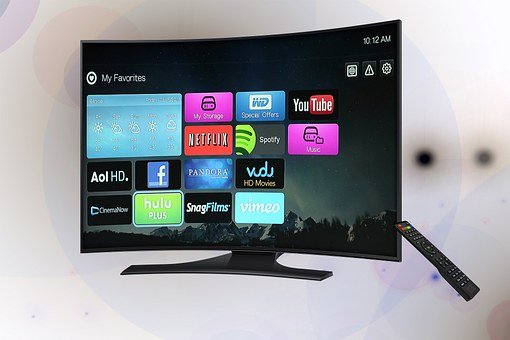
Those of us of a certain age remember television as a fairly simple concept and the device that delivered the shows didn’t change much over the decades. You had a limited selection of channels to choose from, though you could gain a few more if you paid for cable.
In last year’s CES keynote address, Terry Crews, host of America’s Got Talent and one of the stars of Brooklyn Nine-Nine noted, “I remember having to watch whatever was on when I was a kid, but now you can pick and choose at any time what you want, when you want it.”
In contrast, television today offers a lot more options. The picture quality is light years ahead of what it was, not just in the last century but even in the beginning of this one. Also, thanks to its integrations with other technologies, it can deliver a lot more than basic programming or games.
The following are the seven key technologies that have changed the television landscape.
High-Definition Television (HD TV)
While we all know that TV started out delivering pictures in black and white, and that color only became common in the late 1960s, the television set changed very little over close to half a century. That’s because television didn’t evolve beyond analog technology until relatively recently.
The image you see on a television screen is built up from individual pixels. In standard definition TV—what those of us born in the last century grew up with—you have an image built out of 480 rows of pixels with 640 columns in each row.
Increasing the number of pixels substantially is what increases the level of resolution. That became possible as a result of the shift to digital technology.
HD TVs have been evolving so that what counted back in 2005 will not impress anyone today. Back in 2005, there was HD Ready, which delivered a minimum resolution of 720 rows.
That was soon supplanted by what is called Full HD (FHD). The total number of pixels used for the resolution of FHD is typically 1920 x 1080. That amounts to 2 megapixels, which is nearly 7 times the the 0.3 megapixels found in an SDTV screen.
Today, every TV you’d find currently for sale would be up to the “HD Ready,” standard. That means it can offer a resolution of 1280×720 (720p).
4K TV
TVs continued to evolve even beyond the FHD and so we have a new name to designate the quantitative advance that yields a qualitatively better picture. While some refer to this picture quality as Ultra HD (or UHD), others take the more precise name from the number of pixels required. As explained in MakeUseOf, “4K refers to any display format with a horizontal resolution of approximately 4,000 pixels.”
Remember FHD depends on 1920 x 1080 pixels. In contrast, 4K packs in around four times as many pixels with its 3840×2160 setup. That’s super-duper high resolution.
That’s not even the ultimate resolution on the market today. MakeUseOf mentions the possibility of “Full Ultra HD, sometimes called 8K, which refers to a resolution of 7620×4320” That would deliver a picture 16x that of FHD!
Odds are good, though that this standard will also be supplanted in the near future. But for now, you can pick up an 8K TV starting at about $2K while 4K models are available starting at just a few hundred dollars.
Organic Light Emitting Diode OLED TV
OLED TVs achieve impressive effects through electroluminescence. As Cnet explains, “each tiny OLED pixel in the screen creates light depending on how much electric current you send it.” That is what makes it possible to get the ultimate level of contrast, a key to “excellent picture quality.”
“Since OLED can produce a perfect black, emitting no light whatsoever, its contrast ratio(expressed as the brightest white divided by the darkest black) is technically infinite,” Cnet explains.
That makes it “the only technology capable of absolute blacks and extremely bright whites on a per-pixel basis.” That incredible range of contrast is what makes it considered the very best picture quality.
It also is able to do so on an incredibly light and thin screen that can be rendered flexible enough to curve. That can be an advantage to improving the viewer’s experience, according to OLED-info, which goes into somewhat technical detail:
“The curved screen has a curved trajectory similar to a person’s ‘Horopter Line’ allowing the maintenance of a constant focus.”
It goes on to explain that when viewing a flat screen, what’s on the outer edges is farther away from you than what’s in the center. That creates “ a subtle image and color distortion.” That effect increases in proportion to the size of the screen and the closeness of the viewer. Consequently, curving the screen renders the distance consistent and eliminates that distortion.
Another advantage is that curved screens appear larger and brighter. In addition, the shape “eliminates reflections from ambient lighting on the sides, and it also reduces specular (mirror) reflections.”
Nevertheless, OLED-info admits that bendable screens fell out of favor around 2015. But their time may have come now, as indicated by the announcements of LG’s bendable OLED screen in January 2021.
Connected TV (CTV) or Smart TV
The connection refers to a connection to the internet, and as “smart” is also used for that connotation, another term used for this form of television is Smart TV. It’s also sometimes called Internet TV, though when using that term or even connected TV, you need to clarify if you’re talking about the device that receives the content or the content available on such a device (see the next category).
A Smart TV will usually come with built-in apps for programming delivered over the internet. The thing to remember is that just like the apps on your mobile device, they are picking up data on the user.
That app function is what makes the TVs extremely appealing for advertisers who can learn a lot more about those watching via the app than they can from traditional television ads. But if you value privacy, you may want to think about just how much information you are passively sharing when viewing through a connected TV.
Another thing to bear in mind that the operating systems on most are not upgradable. That means that if you want to use that TV for a new app or service that emerges, it may not work for that and may generally be considered obsolete much faster than a standard television set.
Nevertheless, these televisions with built in connections are very popular. Most Americansalready own at least one. Smart TVs can include specifically branded varieties like Android TV. Android, of course is the name adopted by Google for its OS, so it’s no surprise that Android TVs are designed to seamlessly connect to the Google Play Store.
Just like the Android smartphones, they will automatically update apps as they become live in the store. Android TV also includes functions built into smartphones and laptops today, namely voice-activation. That means that your TV remote will contain a microphone that can put you in touch with the Google Assistant to get what you want from it without having to use your hands.
IPTV: Internet TV
It’s not just the device that has changed over time but the source of the content. As cable and satellite TV providers have fallen out of favor over the past few years, people haven’t necessarily given up on TV content but found new forms of content on channels that didn’t exist in the last century.
Internet TV is also sometimes described as Internet protocol television, or IPTV. The streaming content is delivered via a privately-managed network. You can watch Internet TV on a traditional television screen if you add a set-top box at home. But you are not tethered to your set at home, as you can also watch on computer or anywhere you can access the internet by using your mobile device.
The content for internet TV may be broadcast live, but it also can usually be viewed on demand. Internet TV providers store the content on their servers, so they remain accessible. Typically viewers access the content through the provider’s app or log in on the site for access.
Like traditional cable, internet providers offer various packages at different price points. Also like cable companies, they are apt to bundle things you don’t necessarily want with what you do in their subscription services. But you don’t need any special equipment to start streaming your favorites on your selected provider, just enough bandwidth.
Streaming Services and Over The Top Technology (OTT)
OTT can also be identified as streaming content. Like IPTV, OTT relies on the internet, the difference is that it is delivered directly to a viewer’s devices without a privately-managed network. That means there is a direct link between broadcasters and consumers.
The big shift to OTT as a real contender for content consumption came about in 2007 when Netflix shifted from its original business model of providing videos via mail to the OTT model. Netflix remains one of the biggest names in OTT, with over 195 million paid subscribers around the globe.
YouTube also has proven itself to be a powerful influence on video content creation, what was originally the sole domain of television. This is a major part of today’s video creation reshaping TV.
But it has since been joined by several other major players that make up like the growing OTT market, like Amazon Prime Video, Hulu, YouTube Premium and YouTubeTV, among others. The outlay for each of these streaming services is significantly lower than for most cable services, though many people will subscribe to multiple services.
YouTube especially has proven itself to be a powerful influence on video content creation, what was originally the sole domain of television. This is a major part of today’s video creation reshaping TV.
Typically, OTT content is played over a more advanced kind of monitor than your standard TV or even computer. Viewers may opt for an Apple TV, SmartTV, PlayStation, Chromecast, Xbox, or FireStick. Social TV and Second Screen
This refers to a variety of technologies that tie together those consuming television content through digital communication. The actual conduits of such communication can include Connected TVs, as well as computers and mobile devices which may be used for viewing or as second screens, that enable the social interactions that can enhance the experience of fans and possibly give a show a second chance.
As Chris Boggs writes in a blog, “Social TV not only has the potential to put the user in control over the what, when and how they consume TV, but it also allows users to collaboratively define and share their experience.”
You can catch just a glimpse of that can of interactivity in the comments on YouTube videos that show clips from a series with very passionate fans. They also express themselves on Reddit, Facebook groups, and various other forms of social media. Such discussions help reinforce their fandom and can even be channeled to save a show that has been cancelled.
Terry Crews, (whose character on Brooklyn Nine-NIne is also named Terry,) talked about how that show got a second life due to the power of social media at CES 2020. It had originally been carried by Fox, which canceled it after 5 season in May 2018. The next day, NBC picked up the comedy.
Crews observed, “Technology liberates consumers. They have a voice and that’s when it really works.”
Those of us old enough to remember the show Cagney and Lacey (also the names of the Terry character’s twin daughter on Brooklyn Nine-Nine) know that fan support has saved a show back in 1983, and it’s not the only example of old-fashioned letter-writing working to express the sentiment of fans.
The difference between then and now is that with the power of social media, that fan’s voice can gather to a crescendo nearly instantly due to the great reach and attention drawn by social media. So while the pen can be mightier than the sword, the digital pen is far more rapid and sweeping.









